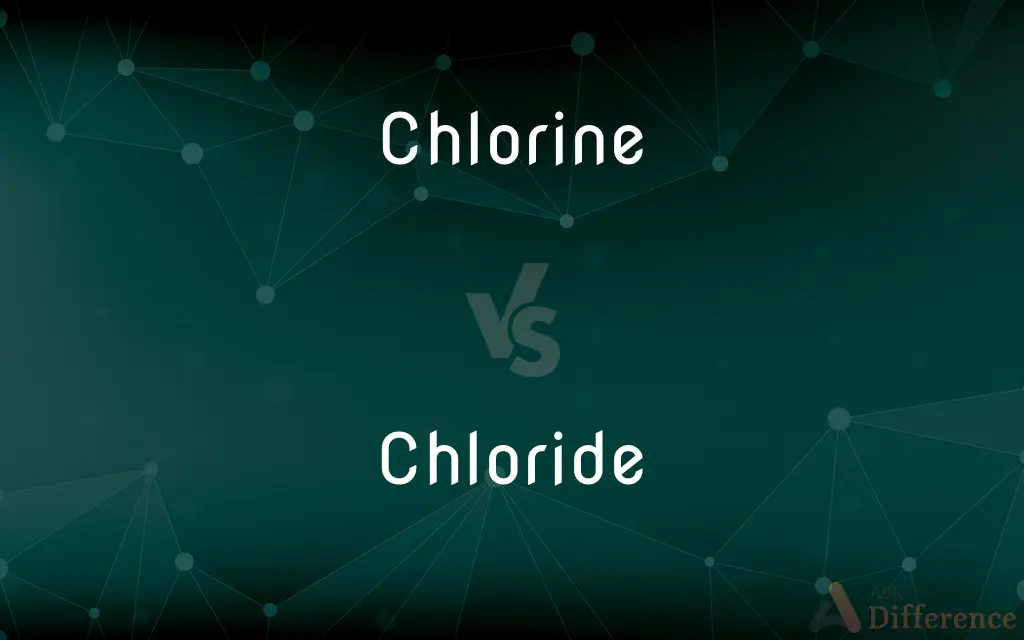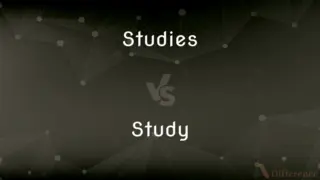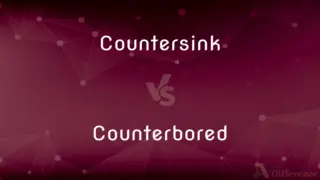Chlorine vs. Chloride — What's the Difference?
By Tayyaba Rehman — Updated on September 19, 2023
Chlorine is a chemical element with the symbol Cl and atomic number 17, usually encountered as a greenish-yellow gas. Chloride is an ion of chlorine that has gained an electron and is usually found in compounds like sodium chloride (table salt).

Difference Between Chlorine and Chloride
Table of Contents
ADVERTISEMENT
Key Differences
Chlorine is a chemical element represented by the symbol Cl and is a member of the halogen group in the periodic table. It usually exists as a greenish-yellow gas at room temperature. Chloride, on the other hand, refers to the negatively charged ion formed when chlorine gains an electron.
In its elemental form, chlorine is a potent oxidizing agent and has applications ranging from water treatment to manufacturing. Chloride is generally encountered in ionic compounds like table salt (sodium chloride) and has a more stable and less reactive nature compared to chlorine.
When discussing the states of matter, chlorine exists primarily as a gas under standard conditions. Chloride, being an ion, does not exist freely but rather forms compounds that are often solid, like sodium chloride, or dissolved in solution, such as in seawater.
Chlorine has a distinctive, strong smell that is often associated with cleaning supplies. Chloride ions are typically odorless and tasteless, becoming detectable to the human senses only when in the form of compounds like table salt.
Comparison Chart
Definition
Chemical element
Ion of chlorine
ADVERTISEMENT
Reactivity
Highly reactive
Less reactive
Common State
Gas
Found in compounds (often solid or dissolved)
Applications
Water treatment, manufacturing
Table salt, biological functions
Chemical Charge
Neutral
Negatively charged
Compare with Definitions
Chlorine
A greenish-yellow gas at room temperature.
The smell of chlorine is often associated with clean water.
Chloride
An ion of chlorine that has gained an electron.
Sodium chloride is composed of sodium ions and chloride ions.
Chlorine
Used in water treatment.
Chlorine effectively kills bacteria in drinking water.
Chloride
Less reactive than chlorine.
Chloride ions are generally stable and less reactive.
Chlorine
A strong oxidizing agent.
Chlorine is used in various industrial processes as an oxidizer.
Chloride
Commonly found in ionic compounds.
Potassium chloride is used in some fertilizers.
Chlorine
A chemical element with the symbol Cl.
Chlorine is used to disinfect swimming pools.
Chloride
Often present in biological systems.
Chloride ions help regulate fluid balance in cells.
Chlorine
A member of the halogen group.
Chlorine shares properties with other halogens like fluorine and bromine.
Chloride
Typically odorless and tasteless.
Chloride ions become noticeable when in compounds like table salt.
Chlorine
Chlorine is a chemical element with the symbol Cl and atomic number 17. The second-lightest of the halogens, it appears between fluorine and bromine in the periodic table and its properties are mostly intermediate between them.
Chloride
The chloride ion is the anion (negatively charged ion) Cl−. It is formed when the element chlorine (a halogen) gains an electron or when a compound such as hydrogen chloride is dissolved in water or other polar solvents.
Chlorine
A highly irritating, greenish-yellow halogen element, existing as a diatomic gas, Cl2, and capable of combining with nearly all other elements, produced principally by electrolysis of sodium chloride and used widely to disinfect water, as a bleaching agent, and in the manufacture of many important compounds including chlorates, sodium hypochlorite, and chloroform. Atomic number 17; atomic weight 35.453; freezing point -100.5°C; boiling point -34.04°C; specific gravity 1.56 (-33.6°C); valence 1, 3, 5, 7. See Periodic Table.
Chloride
Univalent anionic chlorine, or a compound of chlorine, especially a binary compound of chlorine with a more electropositive element.
Chlorine
A toxic, green, gaseous chemical element (symbol Cl) with an atomic number of 17.
Chloride
(chemistry) any salt of hydrochloric acid, such as sodium chloride, or any binary compound of chlorine and another element or radical
Chlorine
(countable) A single atom of this element.
Chloride
A binary compound of chlorine with another element or radical; as, chloride of sodium (common salt).
Chlorine
One of the elementary substances, commonly isolated as a greenish yellow gas, two and one half times as heavy as air, of an intensely disagreeable suffocating odor, and exceedingly poisonous. It is abundant in nature, the most important compound being common salt (Sodium chloride). It is powerful oxidizing, bleaching, and disinfecting agent. Symbol Cl. Atomic weight, 35.4.
Chloride
Any compound containing a chlorine atom
Chlorine
A common nonmetallic element belonging to the halogens; best known as a heavy yellow irritating toxic gas; used to purify water and as a bleaching agent and disinfectant; occurs naturally only as a salt (as in sea water)
Chloride
Any salt of hydrochloric acid (containing the chloride ion)
Common Curiosities
How do Chlorine and Chloride differ?
Chlorine is a chemical element, while Chloride is its ionized form.
What is Chlorine?
Chlorine is a chemical element with the symbol Cl and atomic number 17.
What is Chloride?
Chloride is an ion formed when chlorine gains an electron.
Is Chlorine dangerous?
Chlorine is highly reactive and can be hazardous in high concentrations.
Is Chlorine a gas?
Yes, chlorine exists primarily as a gas under standard conditions.
Is Chloride a solid?
Chloride is often found in solid compounds like sodium chloride.
Where is Chlorine used?
Chlorine is used in water treatment, manufacturing, and as an oxidizing agent.
Can you smell Chlorine?
Yes, chlorine has a strong, distinct odor.
Can you smell Chloride?
No, chloride ions are typically odorless.
Is Chlorine used for cleaning?
Yes, chlorine is commonly used for disinfection and cleaning.
Is Chloride harmful?
Chloride is generally less reactive and less harmful than chlorine.
Are Chlorine and Chloride interchangeable?
No, they have different properties and are used in different contexts.
Where is Chloride found?
Chloride is commonly found in table salt and in biological systems.
Is Chloride used in food?
Yes, chloride is commonly found in table salt, which is used in food.
Are Chlorine and Chloride the same?
No, chlorine is the elemental form, and chloride is the ionized form.
Share Your Discovery

Previous Comparison
Studies vs. Study
Next Comparison
Countersink vs. CounterboredAuthor Spotlight
Written by
Tayyaba RehmanTayyaba Rehman is a distinguished writer, currently serving as a primary contributor to askdifference.com. As a researcher in semantics and etymology, Tayyaba's passion for the complexity of languages and their distinctions has found a perfect home on the platform. Tayyaba delves into the intricacies of language, distinguishing between commonly confused words and phrases, thereby providing clarity for readers worldwide.














































